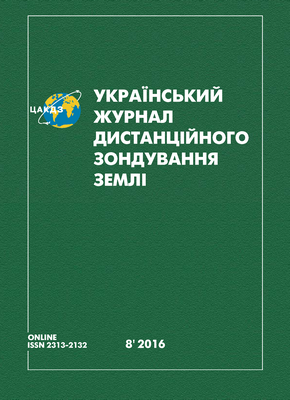Prospecting point of active on the latest stage development geostructures of the Ukrainian shield and its slopes study
DOI:
https://doi.org/10.36023/ujrs.2016.8.73Keywords:
neotectonics, the latest movements, lineament, lineament zone, the ring structure, the Pliocene-Quaternary vertical movements, geological structure, uranium, miningAbstract
Based on co- analysis results of complex structural, geomorphological (morphografic, morphometric) and aerospace geological research with mineral resources data of Ukrainian Shield and its slopes are given, the main types active structures on the latest stage of development for ore are described.
References
Verkhovtsev V. G., Yuskiv Yu. V. (2011). The main principles of drawing up a map of the latest tectonics of the Ukrainian shield and its slopes on a scale of 1:500,000 based on morphographic, morphometric and aerospace data: terminology, methods and methodological techniques, classification and other aspects of research. Technogenic environmental security and civil protection. Vol. 3. P. 63–76.
Verkhovtsev V. G., Yuskiv Yu. V., Shvaiko V. G. (2012). Linear geostructures of the Ukrainian shield and its slopes are active at the latest stage of development. Technological and environmental safety and civil protection. Vol. 4. P. 49–59.
Verkhovtsev V. G. Yuskiv Yu. V., Shvayko V. G. (2012). Ring geostructures of the Ukrainian Shield and its slopes are active at the latest stage of development. Technological and environmental safety and civil protection. Vol. 5. P. 103–118.
Storchak N. P. (Ed.) (1984). Precambrian Geology and Metallogeny of the Ukrainian Shield: a set of 1:1,000,000 scale maps (geological, geological formations, metamorphic facies, fault-block tectonics, geochemical and metallogenic). Kyiv, CTE Mingeo of the Ukrainian SSR.
Zarytsky A. I. (Ed.) (1992). Geology and metallogeny of the southwestern part of the East European platform, scale 1:1000000: set of maps (scheme of the deep structure of the lithosphere, structural-formation map, map of structural zoning, metallogenic map). Kyiv, GHP "Geoprognoz".
Dynamics of geostructures of Ukraine and the general regularities of the placement of minerals (1999). Report on the GDR (final). Leader O. I. Slenzak, executors V. Ya. Radzivil, V. G. Verkhovtsev et al., IGN of the National Academy of Sciences of the National Academy of Sciences. Kyiv, 1999. 218 p. No. DR 0198U003815.
Zones of tectonic activation of geostructures of Ukraine in connection with the prediction of environmentally hazardous processes and forecasting of some types of minerals (2004). Report on the GDR (final). Leader V. Ya. Radzivil, executors V. G. Verkhovtsev, I. S. Potapchuk et al., IGN NASU. Kyiv, 346 p. No. DR 0204U006917.
Gursky D. S. (Ed.) (2002). Metallogenic map of Ukraine. — 1:1,000,000.
Kalashnikova O.I. (Ed.) (2014). Prospects for the development of the uranium raw material base of the nuclear energy industry of Ukraine. Kyiv, Naukova dumka, 2014.
Fault tectonics of Ukraine and localization of minerals (Ukrainian shield and Azov-Black Sea region) (1995). Report on the GDR (final). Leader I. I. Chebanenko, executors O. I. Slenzak, V. Ya. Radzivil et al., IGN of the National Academy of Sciences of the National Academy of Sciences. Kyiv, 1995. 202 p. No. DR 01.9.1002.4949.
Fault geostructures of the Ukrainian shield and its slopes, their spatio-temporal relationships and recent activation (2009). Report on the GDR (final). Head V. G. Verkhovtsev, IGN of the National Academy of Sciences of the National Academy of Sciences. Kyiv, 2009. 250 p. No. DR 0105U001004.
Verkhovtsev V. G. et al. (2013). Total amplitudes of the Late Pliocene-Quaternary vertical movements of the earth's surface of the Ukrainian shield and its slopes. Technological and environmental safety and civil protection. Vol. 6. P. 38–52.
Downloads
Published
How to Cite
Issue
Section
License
Licensing conditions: the authors retain their copyrights and grant the journal the right of first publication of a work, simultaneously licensed in accordance with the Creative Commons Attribution License International CC-BY, which allows you to share the work with proof of authorship of the work and initial publication in this journal.
The authors, directing the manuscript to the editorial office of the Ukrainian Journal of Remote Sensing of the Earth, agree that the editorial board transfers the rights to protection and use of the manuscript (material submitted to the journal editorial board, including such protected copyright objects as photographs of the author, drawings, charts, tables, etc.), including reproduction in print and on the Internet; for distribution; to translate the manuscript into any languages; export and import of copies of the journal with the article of the authors for the purpose of distribution, informing the public. The above rights are transferred by the authors to the editors, without limitation of their validity, and in the territory of all countries of the world without limitation, including in Ukraine.
The authors guarantee that they have exclusive rights to use the submitted material. The editors are not liable to third parties for breach of data by the authors of the guarantees. The authors retain the right to use the published material, its fragments and parts for personal, including scientific and educational purposes. The rights to the manuscript are considered to be transferred by the authors of the editorial board from the moment of the publication of the issue of the journal in which it is published. Reprinting of materials published in the journal by other individuals and legal entities is possible only with the consent of the publisher, with the obligatory indication of the issue of the journal in which the material was published.
